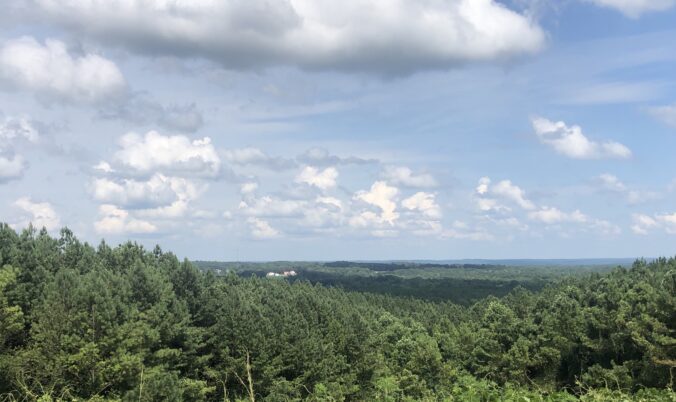by Delbert Reed Reprint -- Published in The Northport Gazette, April 7, 2004
I had to go back to Reed Mountain in northern Tuscaloosa County last week. Something drew me there to stand at the old home place of my ancestors and look out on the wide, breath-taking vistas to the East and wonder about the history of the Reed family.
There is little left to prove that anyone ever lived at the site now except a few rocks, likely from the foundation or chimney, and a thriving wisteria vine, which was covered with bumblebees on the late afternoon that I visited.
I listened for sounds from the past, like the tolling of the old dinner bell or the chopping of wood, and I watched for wispy images of people I might know as the sun began to cast shadows on the hill, but there was none of either.
I could see, though, why someone would want to live on Reed Mountain. That spectacular view toward the faraway bottomland beside the small, clear stream below had me dreaming for a moment, too, although the place is generally poorly suited for farming in many ways. Those red-land hills and hollows are far more suited for hunting.
But my great grandparents Wes and Leona Reed raised 12 children to adulthood on the place and farmed a large area first owned, by all accounts, by Wes’s father Thomas Reed, the first Reed known to have settled in the country near Haygood Methodist Church. Thomas likely walked or rode a mule or wagon from Georgia if he was typical of the Southern Scots-Irish settlers. All I know of his wife is that her name was Parthenia Moore and that she was from the Moore’s Bridge area.
I imagined the large Wes Reed family meal time and wondered just how much food they had to grow and can to manage through the winters. I wondered just how many biscuits Omie, as Leona was called, had to cook each morning before sending her family into the fields.
Wesley Washington Reed was just 16 years old and Leona Elizabeth Davis only 15 when they married on December 16, 1886, according to family records. My grandfather Ellis, born on December 20, 1887, was the oldest of the children, and he was 25 years old when his grandfather Thomas Reed, born in 1847, died in 1913. The youngest child of Wes and Omie Reed was Elliott, born in 1907. Three children were born dead, including two after Elliott’s birth, and another died at age three.
A photograph of Wes and Omie standing together shows tanned and hard-working people, and a similar photograph of Ellis and my grandmother Viola is quite similar. They seem to be typical of the proud, poor, rural Southerners of the early 1900s.
My dad had an old scrapbook that included several old receipts showing purchases by Wes Reed from the late 1800s until his death in 1938. One was for a yoke of oxen for $30 on May 13, 1897; many were for fertilizer and taxes; one was for a one-ton Ford truck purchased from Tucker Motor Company in 1923 at a cost of $451.40; another was for $9 as “full pay for his child’s tombstone.” Wes had signed some of the notes and mortgages with an “X” for his mark, indicating that he could not write his name.
Unfortunately, there are few photographs of the Reed family from the early days, but there are enough to trace a family resemblance, and there are markers at Haygood Cemetery that help trace the family back in time.
Fortunately, though, the dinner bell from the old Wes Reed place survives today, thanks to the late Carl Harris. That same bell that called the Reed family from the fields or marked a death in the community rests safely in my storage shed, and I promise soon to display it proudly for the memories it holds, for the hands that rang it, and for those who heard it ring so many times.
“I heard that dinner bell ring at 11 o’clock every day for years,” Brazzie Taylor Rodgers said in recalling her years as a neighbor of the Reeds. “Omie always had dinner ready at 11 o’clock. Wes Reed was a good man,” she added. “He walked by our house early nearly every morning on his way to the store to get a box of snuff, and I was at his house the day he died.”
The old Reed place on Reed Mountain was sold many years ago to some large corporation, probably a timber company, and the old house destroyed. When I visited, the timber around the old house place had recently been cut, leaving the area scarred and ugly except for the view across the valley eastward.
But the Reed place was surely a glorious place once, with hunting dogs and teams of mules and oxen and cows and a large family to care for it all. I’d like to think Reed’s Mountain in the old days was much like the mythical Walton’s Mountain depicted on television and that the Reed family was just as happy and loving as the Waltons.
I’d like to think those 12 children grew up with good memories of life on Reed’s Mountain. And I wish I had thought to ask them to share them with me years ago. Now I can only imagine how it must have been.
(Originally Published in The Northport Gazette, April 7, 2004)
Samantha Living would like to thank Delbert Reed for sharing this story. We appreciate his journalism and interest in the Samantha Community. We invite your comments below or send them and any photos you might have to editor@samanthaliving. Please comment below

Leave a Reply